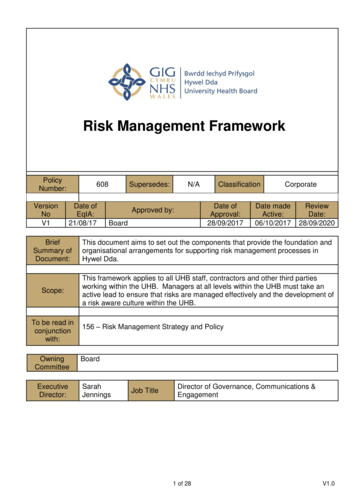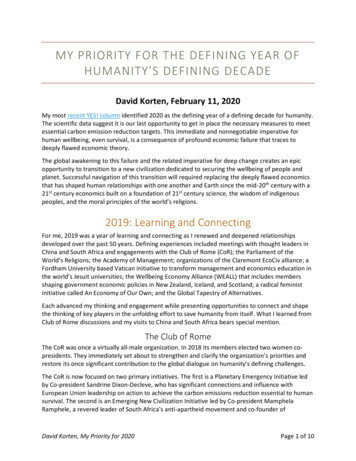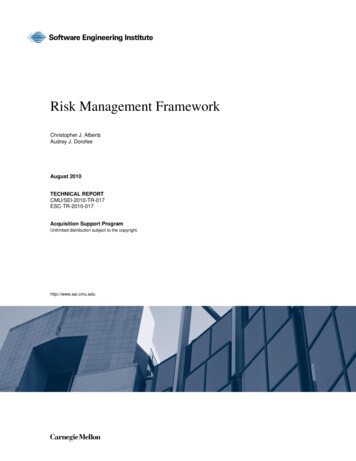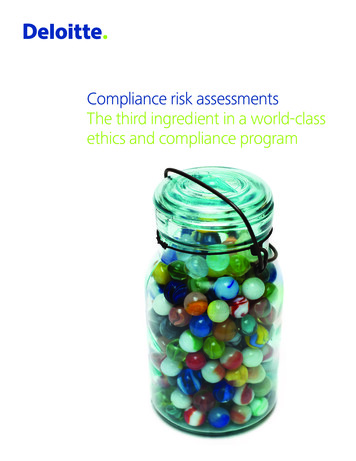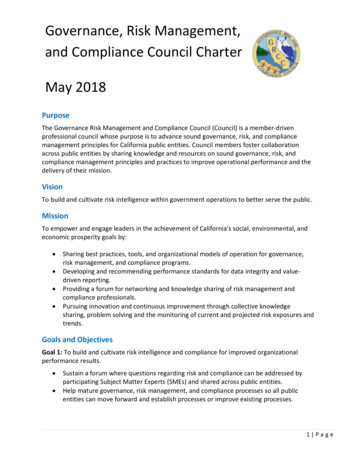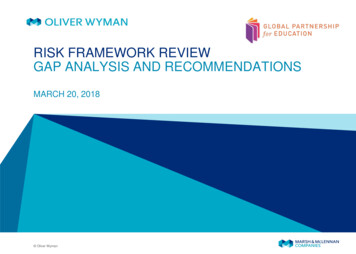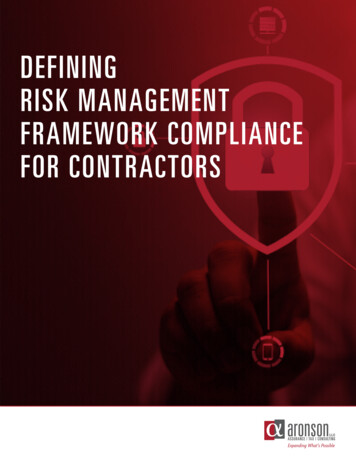
Transcription
DEFININGRISK MANAGEMENTFRAMEWORK COMPLIANCEFOR CONTRACTORS
DEFINING RISK MANAGEMENT FRAMEWORKCOMPLIANCE FOR CONTRACTORS“It is not the strongest or the most intelligent who will survive but those who can bestmanage change.” - Charles DarwinAs cyber threats and attacks continue to increase in scale and impact across organizations of all sizes, cyber securitymust be considered as a key component to both information security and risk management programs. As alluded to inDarwin’s quote above, those who do not adapt their IT environment and risk frameworks to account for the changing threatlandscape may compromise organizational and customer information. Leakage or exposure of information, specifically thatof a classified nature, may cause irreparable harm to not only the organization in question, but also to national security.The U.S. Federal Government has taken notice.As of January 1, 2018, the Defense Security Service (DSS) now requires that all cleared contractors processingclassified information under their watch must fully transition to the new Risk Management Framework (RMF).This new framework establishes a more uniform and consistent approach to managing risk associated with assessing andauthorizing information systems. At a high level, the intent of this new framework is as follows: Manage risk more effectively and efficiently Build trust across the U.S. Federal government Establish a common foundation for information security Streamline DSS processesWhat Does RMF Replace?The RMF replaces the DSS’s Certification and Accreditation (C&A) process and the Department of Defense’s (DoD’s)Information Assurance and Accreditation Process (DIACAP).C&A is a federally mandated standard process which requires national security information systems to meet documentedsecurity requirements and maintain the accredited security posture throughout their system life cycle. C&A is mandated uponall systems of the U.S. Federal Government and is the required step in order to stand up an information system. The C&Aprocess establishes security configurations, controls, policies, and procedures. It also verifies their correct implementation.The National Institute of Standards and Technology (NIST) has developed a four-phase C&A process used by the U.S.Federal Government to certify compliance with mandated federal controls. The four phases are as follows:Initiation & PlanningCertificationAccreditationContinuous MonitoringEach phase has a list of C&A activities that must be completed before beginning the next phase.1
DEFINING RISK MANAGEMENT FRAMEWORKCOMPLIANCE FOR CONTRACTORSWhy Transition To RMF?RMF was established by NIST, in partnership with the DoD, the Office of the Director of National Intelligence (ODNI),and the Committee on National Security Systems (CNSS). The purpose of the RMF transition is to develop a commoninformation security framework for the U.S. Federal Government and its contractors in making risk-based decisions.When discussing the risks associated with an organization’s information systems, considerations must be given but notlimited to: System security Confidentiality Data integrity Availability System compliance with regulatory standards Business continuity Disaster recovery effortsImplementation of the DSS RMF will ensure organizations take these risks and considerations in mind when determiningappropriate risk mitigation strategies.This framework is meant to change the way that government contractors assess their information systems, moving awayfrom an archaic C&A process that largely promoted a “check-the-box” mentality. The prior process limited key stakeholdersfrom having significant input in the initial assessment and later management of the risks associated with information systems.Additionally, this framework is meant to build reciprocity with other federal agencies. By requiring federal agencies andgovernment contractors to adhere to the same risk management standards, trust amongst government stakeholdersregarding how information systems are managed will be built via a more transparent, comprehensive, flexible, andstrategic process.2
DEFINING RISK MANAGEMENT FRAMEWORKCOMPLIANCE FOR CONTRACTORSRMF Six-Step ProcessThe RMF has been broken down into six key steps by the DSS and NIST in order to ease this transition.The figure above outlines the six-step RMP process. Additional information on RMF can be obtained from NIST SP 800-37“Guide for Applying the Risk Management Framework to Federal Information Systems.”3
DEFINING RISK MANAGEMENT FRAMEWORKCOMPLIANCE FOR CONTRACTORS1Categorize the Information SystemEach government contractor must categorize an information system based on the following criteria: Confidentiality – Confidentiality is categorized based on the impact due to the loss of confidentialityof the information within the information system and provided by the company. Integrity – Integrity is categorized based on the impact to the company and DSS if (1) the informationsystem was not operating properly and (2) the information provided by that information systemcould not be relied upon as accurate. Availability–Availability is categorized based on the impact to the company and DSS if theinformation system or the data that it provides is not available when it is needed.Companies must assign a value of low, moderate, or high to each category (excluding confidentiality which canonly be classified as moderate or high).For more information on this step, refer to NIST SP 800-30 “Risk Management Guide for Information TechnologySystems” for additional guidance.2Select Security ControlsSecurity controls must be selected from NIST Special Publication 800-53 Revision 4 framework, which maintainsa corresponding set of controls to implement based on information system categorization. These controls maybe substituted or supplemented by additional controls, as long as risks are mitigated as required by the RMF.Additional control resources based on the information system are provided by the National Industrial SecurityOperating Manual (NISPOM) and Committee on National Security Systems (CNSS).Appropriate personnel from each organization must select and agree on a security control set for eachinformation system as well as a plan to continuously monitor the controls they select. The control set for eachinformation system must effectively identify risks and meet applicable security requirements. These controls willbe documented in the System Security Plan (SSP).For more information on this step, refer to NIST SP 800-53 R4 “Security and Privacy Controls for FederalInformation Systems and Organization” for additional guidance.3Implement Security ControlsAppropriate personnel for each information system must implement the agreed upon control set, and they mayconduct an initial assessment to identify potential weaknesses and deficiencies. Personnel must be qualified toimplement the changes, provide measures to note that the control is operating effectively, as well as documentthe implementation within the SSP.4
DEFINING RISK MANAGEMENT FRAMEWORKCOMPLIANCE FOR CONTRACTORS4Assess Security ControlsA Security Assessment Plan and assessment must be completed for each information system’s control set.Any issues, recommendations, or findings must be documented for submission to the DSS. Any remediationactions conducted based on the findings of the assessment should also documented in the Plan of Action andMilestones (PoAM) document for submission to the DSS.A Security Assessment Report (SAR) must be generated as result of the review of security controls, and the SSPshould be updated with control status/effectiveness as needed.5Authorize the Information SystemAppropriate company personnel must create, review, and submit a security authorization package to theDesignated Authorizing Official (DAO) at the DSS. The DAO assesses the security authorization package andissues an authorization decision for the information system—either Authorization to Operate (ATO) or DeniedAuthorization to Operate (DATO)—which includes any terms and conditions of operation as well as an AuthorizationTermination Date (ATD) if required.6Monitor the Information SystemEach information system must be continuously monitored, tested, and have identified issues remediated inorder to keep its authorization status with the DSS/DoD. The continuous monitoring plan/strategy must beformally documented and will be periodically reviewed by those who approved the plan/strategy. The PoAM andSSP should be updated as needed in order to document the latest operating status of the information system.Who Should Be In Compliance?As noted within the “DSS – Assessment and Authorization Process Manual”:“Cleared contractors processing classified information under the cognizance of DSS will follow the guidance containedwithin this manual to complete the RMF process and obtain IS authorization.”Maintaining compliance and executing the RMF process requires organizations to execute and complete the processes anddocuments discussed within the six steps previously outlined.5
DEFINING RISK MANAGEMENT FRAMEWORKCOMPLIANCE FOR CONTRACTORSIn order to show information system compliance, organizations must produce the following seven key documentsto the DSS:1.Requirements Document2. Risk Assessment Report (RAR)3. System Security Plan (SSP)4. Security Assessment Report (SAR)5. Information System Security Manager (ISSM) Certification Statement6. Plan of Action & Milestones (PoAM)7.Authorization Decision Letter for SignatureThese seven documents are required for each information system processing classified information. Those familiar withthe C&A process will notice some similarities between the processes. However new terminology is now in place, inaddition to new requirements and responsibilities for stakeholders in RMF execution. As compared to the C&A process, theRMF process will require the inclusion of additional artifacts when government contractors submit a security authorizationpackage to DSS.For organizations that are unable or unwilling to produce the seven key documents noted above, the ramification to theirbottom line will likely be negative, and they may not fully realize the downstream impacts non-compliance may have ontheir business.So What If I Don’t Act?Although the deadline for these requirements was January 1, 2018, these documents do not need to be available to theDSS until your company’s next security vulnerability assessment.However, by not adhering to the RMF, organizations stand to be non-compliant with DSS standards. This may result in lossof business from government clients until compliance is achieved, resulting in lost opportunities, decrease in goodwill, andreputational impacts.Also, implementing the RMF will streamline DSS processes to support the authorization of any new information systemprocessing classified information as part of the National Industrial Security Program (NISP), decreasing time to beginworking on new engagements.Don’t let inaction or hesitation on meeting government requirements impede continued business for yourorganization. Taking initial steps to implement the RMF will not only put you in the right direction for compliance, but it willalso strengthen your organization’s internal information security and risk management programs.Now is the time to start promoting synergy across all DSS stakeholders and begin the transition to the RMF.Selecting a firm with rooted knowledge in the organizational change requirements to assist is often the best first steporganizational leaders can make.6
DEFINING RISK MANAGEMENT FRAMEWORKCOMPLIANCE FOR CONTRACTORSHow Aronson Can HelpWhile the RMF steps outlined above may be considered vague as to what is acceptable, Aronson has dealt with thistransition before. Our team has the necessary expertise to ease the burden of the transition to the RMF and help yourorganization navigate: What is acceptable to the DSS What documents are required to be in compliance How to expertly compose these documents The NIST frameworks that drives the change in compliance requirementsWe have the ability to effectively assist you with this transition, while allowing you and your organization’s personnel tofocus on what’s important: your core business.By attempting to make this transition on your own, you may risk inconsistency and inefficiency across departments whichultimately drives increasing costs and greater risks to your company as a whole. Our consistent approach will minimize thedisruption to your business and reduce the risks associated with making changes to your information systems and internalcontrols if necessary. Let our experienced team provide guidance on how to achieve RMF compliance.INTERESTED IN LEARNING MORE?FOR MORE INFORMATION, CONTACT PAYAL VADHANI, LEAD PARTNER OF ARONSON’S CYBERSECURITY, RISK &COMPLIANCE PRACTICE, AT PVADHANI@ARONSONLLC.COM OR 301.231.6259.PAYAL VADHANI, MBA, IT-CMFPARTNERpvadhani@aronsonllc.comRENZO PORTELLA, CISSP, CISAMANAGERrportella@aronsonllc.comBRIAN ELLISSENIOR CONSULTANTbellis@aronsonllc.comAbout Aronson LLCAronson LLC provides a comprehensive platform of assurance, tax, and consulting solutions to today’s most active industrysectors and successful individuals. For more than 55 years, we have purposefully expanded our service offerings anddeepened our industry specialties to better serve the needs of our clients, people, and community. From startup to exit,we help our clients maximize opportunity, minimize risk, and unlock their full potential. For more information about AronsonLLC, please visit www.aronsonllc.com or call 301.231.6200.7
Information Assurance and Accreditation Process (DIACAP). . (DAO) at the DSS. The DAO assesses the security authorization package and issues an authorization decision for the information system—either Authorization to Operate (ATO) or Denied Authorization to Operate (DATO)—which includes any terms and conditions of operation as well as an .
